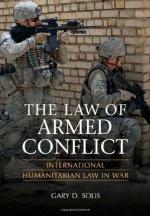|
This section contains 3,015 words (approx. 11 pages at 300 words per page) |

|
International humanitarian law (IHL) is the body of treaty and customary international law that regulates the behavior of states in armed conflict. IHL has two primary purposes. First, it protects those who do not participate or are no longer participating in armed conflict, including sick and wounded soldiers, prisoners of war, and civilians. Second, it regulates the means and methods that states may legally use to carry out armed conflict. The primary sources for modern IHL are the four Geneva Conventions of 1949 and the Additional Protocols of 1977.
Although much of IHL is concerned specifically with international armed conflict, each of the Geneva Conventions contains an identical article, known as Common Article Three, that concerns non-international conflicts. The Additional Protocol II of 1977 also regulates behavior in non-international conflicts. A number of other international agreements have sought to regulate the types of weapons that may be...
|
This section contains 3,015 words (approx. 11 pages at 300 words per page) |

|


